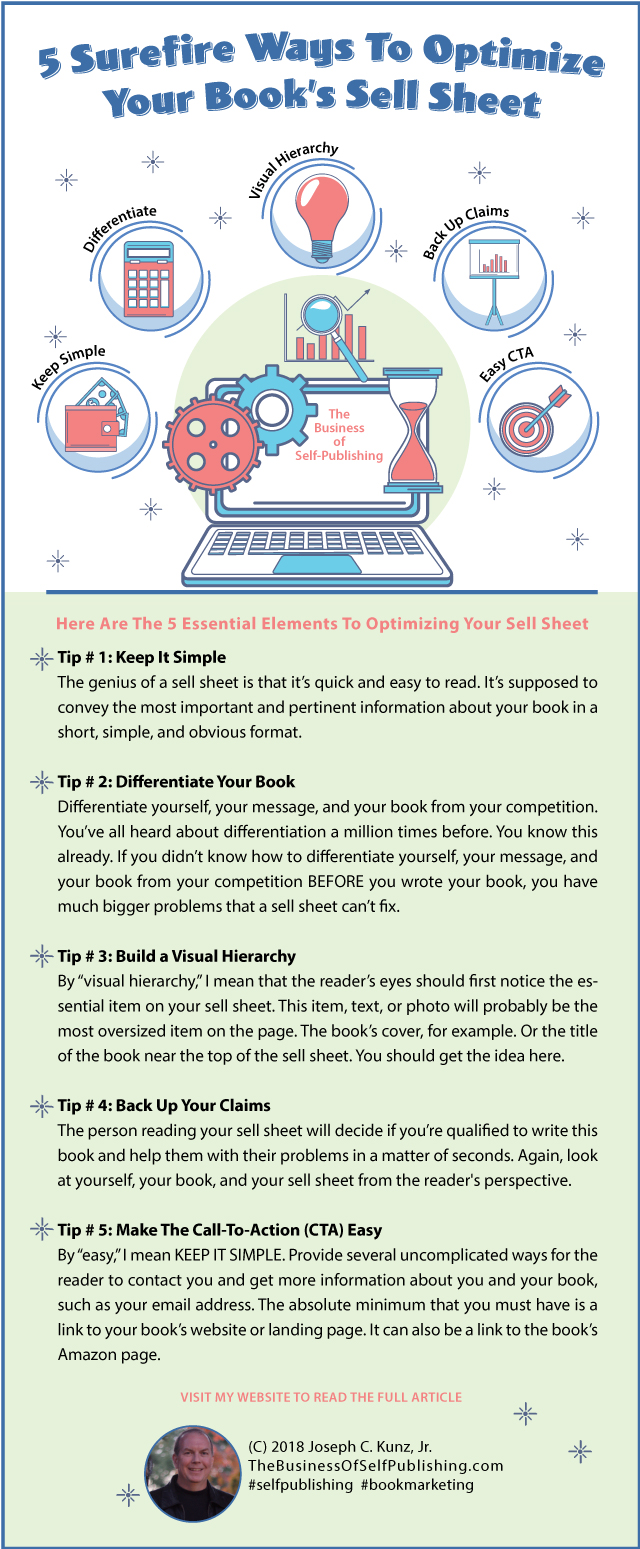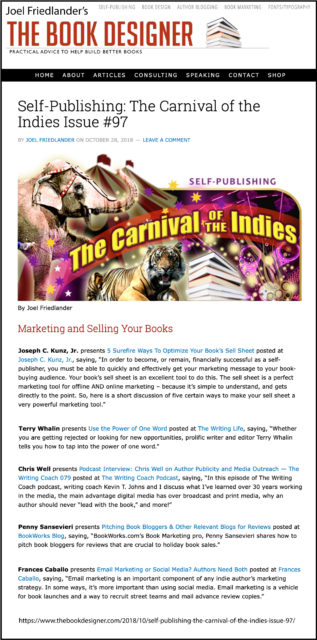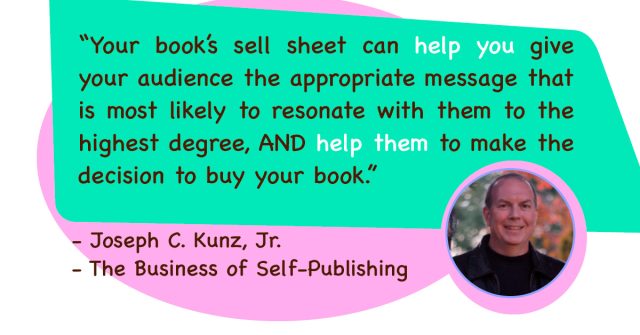Podcast: Play in new window | Download
Subscribe: Apple Podcasts | Spotify | Pandora | RSS | More
Updated December 10, 2022
Synopsis
To become or remain financially successful as a self-publisher, you must be able to quickly and effectively get your marketing message to your book-buying audience. Your book’s sell sheet is an excellent tool to do this. The sell sheet is a perfect marketing tool for offline AND online marketing – because it’s simple to understand and gets directly to the point. So, here is a short discussion of five specific ways to make your sell sheet a potent marketing tool.

What You Will Learn
1. You will learn about the five essential elements you must incorporate into your book’s sell sheet.
2. You will learn how and why these elements are essential for your book’s success.
3. You will learn the five most important ways to optimize your sell sheet so that people want to read it.
Introduction
To become or remain financially successful as a self-publisher, you must be able to quickly and effectively get your marketing message to your book-buying audience. Your book’s sell sheet is an excellent tool to do this. The sell sheet is a perfect marketing tool for offline AND online marketing – because it’s simple to understand and gets directly to the point.
And, as The Professor likes to say, it’s “no fuss, no muss, no waste, no bother” for you or the buyer. (He has many insightful gems like that. I hear them all the time. He has one for every imaginable situation. But he’s a wealthy business genius, so we all listen.)

Here Are The 5 Essential Elements To Optimizing Your Sell Sheet:
Sell Sheet Optimization Tip # 1: Keep It Simple
The genius of a sell sheet is that it’s quick and easy to read. It’s supposed to convey the most important and pertinent information about your book in a short, simple, and obvious format.
And it must be appealing to look at and read while doing all of that. All of the information on the sell sheet must only be concerned with your book. No extraneous information is necessary. In other words, don’t oversell or exaggerate.
Get to it quickly. You only have about 30 seconds to hold onto the person reading your sell sheet. Use every inch of that sell sheet very wisely. Ask yourself: “What information is necessary to help the buyer find out more about my book or go directly to buying it?”

Sell Sheet Optimization Tip # 2: Differentiate Your Book
Differentiate yourself, your message, and your book from your competition. You’ve all heard about differentiation a million times before. You know this already. If you didn’t know how to differentiate yourself, your message, and your book from your competition BEFORE you wrote your book, you have much bigger problems that a sell sheet can’t fix.
Your message that you want, or need, to share with your reading audience and how you write about it needs to come through on your book’s sell sheet. Look at yourself, your message, and your book from the perspective of your audience, readers, and customers. Now show them how you and your book are different, better, or more insightful for your book’s subject matter than your competition is.
Sell Sheet Optimization Tip # 3: Build a Visual Hierarchy
By “visual hierarchy,” I mean that the reader’s eyes should first notice the essential item on your sell sheet. This item, text, or photo will probably be the most oversized item on the page. The book’s cover, for example. Or the title of the book near the top of the sell sheet. You should get the idea here.
Then their eyes should be drawn to the second most important item on your sell sheet. Maybe this is a word or statement about the book’s subject matter. The text here might be bigger or more colorful than the other text on the page. Then on to the third most crucial information you want the reader to see next. And so on.
Typically, these items start at or near the top of the page, where most people first look on paper. And, when viewing on a computer screen, almost always from the top down. Your goal is to help the reader navigate your sell sheet in a pleasant, visually appealing, and easy-to-read format.
Sell Sheet Optimization Tip # 4: Back Up Your Claims
The person reading your sell sheet will decide if you’re qualified to write this book and help them with their problems in a matter of seconds. Again, look at yourself, your book, and your sell sheet from the reader’s perspective.
And then ask yourself several questions: “Is this person believable? Does this person look and sound like he can help me with my problems? Help me improve my life? Help me find the answers I need?” Does he have believable qualifications that prove he can write about this book’s topic?”
Remember, every word and picture on that sell sheet can help or hurt your credibility. You must convey your claims about your book and your qualifications to the reader in a believable way. Too much embellishment or boasting, and you will lose them – in a matter of seconds – and they won’t return.
Sell Sheet Optimization Tip # 5: Make The Call-To-Action (CTA) Easy
By “easy,” I mean KEEP IT SIMPLE. Provide several uncomplicated ways for the reader to contact you and get more information about you and your book, such as your email address. The absolute minimum that you must have is a link to your book’s website or landing page. It can also be a link to the book’s Amazon page.
If your book is available for sale to bookstores, libraries, and universities, you should mention that your book is available through book distributors Ingram, and Baker and Taylor, for example. But keep it simple and easy! Remember how your book’s demographic, readers, buyers, customers, and clients, will most likely want to contact you.

Conclusion
Don’t be afraid to have more than one sell sheet for your book. You can create one more directed toward your clients, for example, visiting your office, and one for the people that read your blog. And you can create one for libraries and schools. You wrote the book, so you already know who your audience, or audiences, is for your book.
Your book’s sell sheet can help you give your audience the appropriate message that is most likely to resonate with them to the highest degree and help them to decide to buy your book.
Creating a good sell sheet for your book is “no fuss, no muss, no waste, no bother” for you or the buyer. (Oh no! Now I’m doing it!)
Questions For Us To Think About And Discuss
1. How many different calls-to-action do you have on your sell sheet?
2. Which ones are more effective for each audience?

